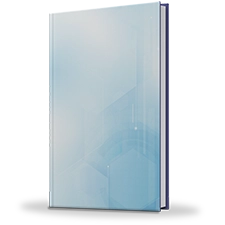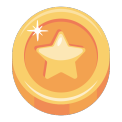Smart Water Bottle Market Research, 2035
The global smart water bottle market size was valued at $256.9 million in 2023, and is projected to reach $896.6 million by 2035, growing at a CAGR of 11.2% from 2024 to 2035. A smart water bottle is a technologically advanced hydration container designed to track and improve daily water intake. Hydration tracking sensors, Bluetooth or Wi-Fi connectivity, and app integration provide real-time reminders, consumption data, and temperature control. Some models sync with fitness apps, allowing users to monitor hydration alongside activity levels. The bottles support healthier hydration habits by sending alerts or visual cues, which makes them useful for individuals focused on fitness, professionals, and those aiming for improved wellness.

Market Dynamics
The expansion of fitness and wellness trends globally has increased demand for bottles embedded with smart technologies durng the smart water bottle market forecast. More individuals are engaging in physical activities such as sports, gym workouts, and outdoor training, leading to increased awareness of proper hydration. Smart water bottles equipped with hydration reminders, app connectivity, and real-time tracking support hydration management based on activity levels. Integration with health and fitness apps allows users to monitor water intake and adjust consumption for better performance. According to the Sports & Fitness Industry Association (SFIA), fitness participation in the U.S. reached 205.8 million in 2022, rising by 800,000 year-over-year. Increased engagement in marathons, cycling events, and high-intensity training has boosted awareness of hydration management, which in turn has driven the adoption of smart water bottles.
In addition, consumers focused on fitness and overall well-being are more likely to invest in premium hydration products. Smart water bottles offer convenience, customization, and data-driven insights, which has made them a valuable addition to daily routines. Moreover, corporate wellness programs promoting healthier lifestyles among employees contribute to market growth, encouraging the adoption of smart water bottles. Thus, increased awareness of hydration’s role in physical and mental performance drives demand across various demographics. Expanding product innovations, including temperature control and voice assistant compatibility further strengthen the smart water bottle market share as smart hydration becomes an integral part of modern health-conscious lifestyles.
Even though the market has experienced rapid growth, there are certain factors that hinder market expansion. The high cost of smart water bottles compared to traditional options has restrained market demand for smart water bottles. Advanced features such as hydration tracking, Bluetooth connectivity, self-cleaning technology, and temperature control contribute to higher production costs, leading to premium pricing. Many consumers hesitate to invest in smart water bottles when traditional alternatives are available for as low as $5 to $20, while smart versions range between $50 and $100. Cost-conscious buyers, particularly in price-sensitive regions, prioritize affordability over technological advancements, which limits the adoption of smart water bottles. While long-term benefits such as durability and reusable features may justify the price for some consumers, the initial cost remains a barrier to wider market penetration of smart water bottles.
Moreover, manufacturers in the industry are working to address cost concerns through product differentiation and pricing strategies. Lower-cost models with essential features are being introduced to reach more consumers and make smart water bottles more affordable. However, integration of advanced technology still requires higher manufacturing expenses, which leads to higher prices as compared to traditional bottles. Limited awareness of the long-term value smart water bottles provides further impacts purchasing decisions. Thus, affordability challenges are anticipated to slower smart water bottle market growth, particularly in regions where disposable income influences purchasing behavior.
Furthermore, growth in corporate wellness programs and increasing demand for sports hydration solutions are creating market opportunities for the global smart water bottle industry. Many organizations, including Google, Microsoft, and Deloitte, are prioritizing employee well-being by introduction of wellness initiatives that encourage proper hydration. Smart water bottles with hydration tracking, intake reminders, and app connectivity align with corporate health programs aimed at improving productivity and overall workforce health. Companies include smart water bottles in employee welfare programs as incentives, health benefits, and workplace hydration initiatives to promote better hydration, improve productivity, and support overall well-being, which has significantly driven the smart water bottle market demand in recent years. Corporate gifting trends have further supported market expansion, with businesses selecting smart water bottles as high-value gifts for employees and clients as part of wellness-driven engagement strategies.
Also, the rise in sports hydration solutions has contributed to market growth, particularly among professional athletes, sports teams, and fitness programs. Organizations such as the NBA, NFL, and Olympic training centers have integrated smart water bottles into structured hydration plans for optimizing performance and recovery. Training centers, sports academies, and recreational programs are incorporating smart hydration solutions to ensure consistent fluid intake. Thus, growing awareness of hydration’s role in endurance and muscle function has increased adoption across workplace wellness and athletic applications, driving market expansion.
Segmental Overview
The smart water bottle market is divided into technology, material, price range, distribution channel, and region. Based in technology, the market is segmented into hydration tracking sensors, temperature control UV-C sterilization, Bluetooth/Wi-Fi connectivity. Based on material, the market is categorized into stainless steel, plastic, and others. Based on price range, the market is bifurcated into economy, and premium. Based on distribution channel, the market is classified into supermarkets-hypermarkets, departmental stores, online sales channel, and others. By region, the market is analyzed across North America (U.S., Canada, and Mexico), Europe (Germany, UK, France, Italy, Spain, and rest of Europe), Asia-Pacific (China, Japan, India, South Korea, Australia, Singapore, and rest of Asia Pacific), and LAMEA (Brazil, Argentina, South Africa, Saudi Arabia, UAE, and rest of LAMEA).
By Technology
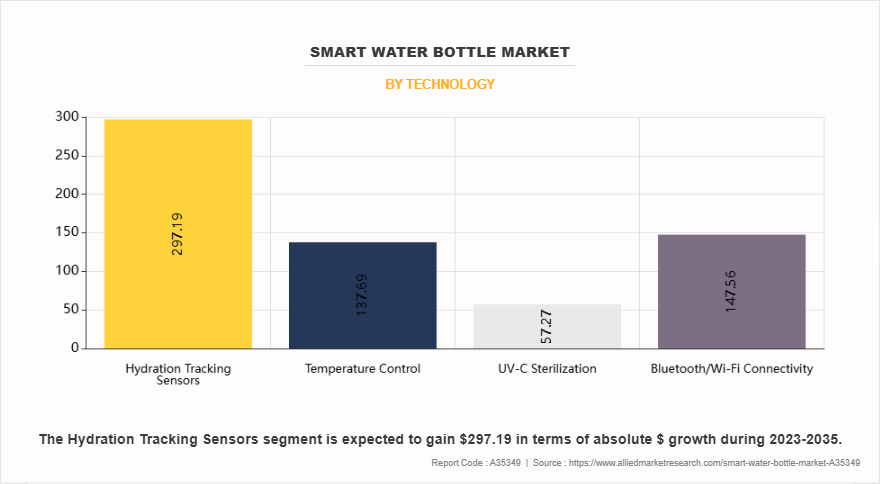
By technology, hydration tracking sensors segment dominated the global smart water bottle market in 2023 and is anticipated to maintain its dominance during the forecast period. Growing health awareness has increased demand for real-time hydration monitoring, with consumers prioritizing smart bottles that sync with mobile apps and wearable devices to provide personalized water intake recommendations. Athletes and fitness users rely on hydration tracking features to monitor fluid intake and improve performance. Corporate wellness programs promote adoption by integrating smart water bottles into workplace health initiatives. Advancements in sensor technology have improved accuracy and battery efficiency, which has made hydration tracking features more reliable. Rising concerns over dehydration-related health issues have increased adoption among health-conscious individuals further driving this segment. The emphasis on data-driven hydration management continues to influence purchasing decisions, with hydration tracking sensors remaining a preferred option for those seeking accurate and convenient solutions.
By Material

By material, stainless steel segment dominated the global smart water bottle market in 2023 and is anticipated to maintain its dominance during the forecast period. Durability and insulation properties have positioned stainless steel as a leading segment, as it allows water to remain at desired temperatures for extended periods. Consumers focused on sustainability favor stainless steel over plastic owing to its reusability and resistance to wear. Health-conscious individuals prefer stainless steel bottles since they do not leach chemicals, addressing concerns over plastic alternatives. Regulatory measures discouraging single-use plastics have further contributed to demand for stainless steel smart water bottles. The premium aesthetic and compatibility with advanced smart features, such as temperature control and hydration tracking, have strengthened adoption among consumers. The expanding availability across online and offline retail channels has increased access to stainless steel smart water bottles, which attract those who prioritize durability and advanced functionality.
By Price Range
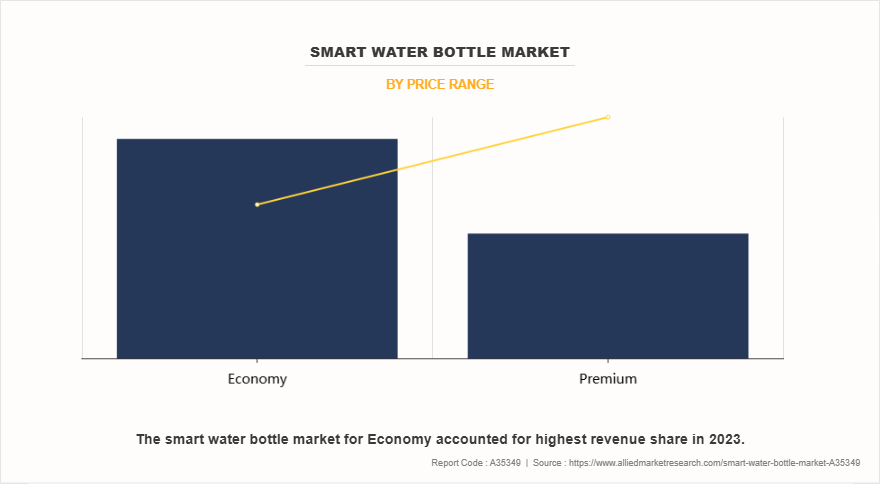
By price range, the economy segment dominated the global smart water bottle market in 2023 and is anticipated to maintain its dominance during the forecast period. Price-sensitive consumers in regions such as Asia-Pacific and LAMEA prefer cost-effective options with essential smart features such as hydration reminders and Bluetooth connectivity. Manufacturers prioritize durable plastic and stainless steel materials to balance affordability with functionality, ensuring competitive pricing. Bulk purchasing by fitness centers and sports facilities supports demand in this segment. The rising adoption of budget-friendly health gadgets among young adults and first-time users has strengthened the market share of this category. In addition, brands focus on integrating app-based hydration tracking without high-end customization, ensures that economy smart water bottles remain a practical and attractive option for a wide consumer base.
By Distribution Channel
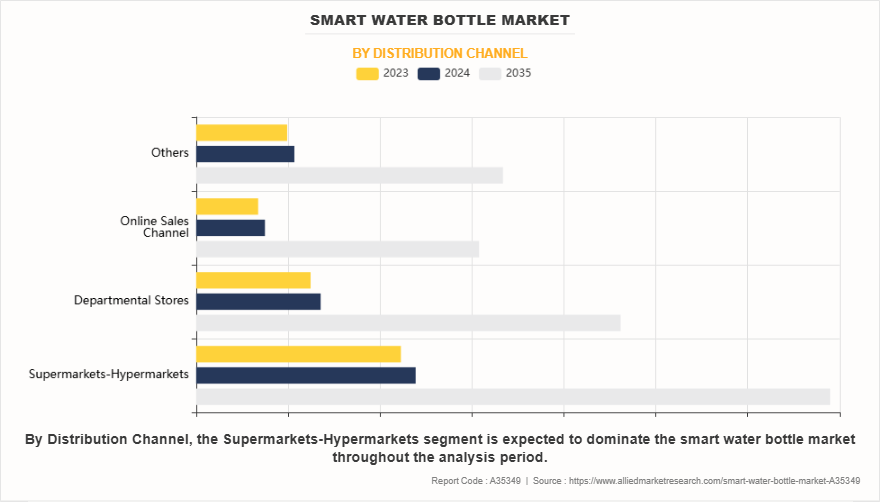
By distribution channel, supermarkets-hypermarkets segment dominated the global smart water bottle market in 2023 and is anticipated to maintain its dominance during the forecast period. Consumers prefer these retail outlets for their ability to provide hands-on product evaluation, competitive pricing, and promotional discounts. The presence of well-organized shelves and dedicated fitness and wellness sections further supports visibility and accessibility for smart water bottles. Retailers focus on stocking a variety of brands, price ranges, and features, catering to both budget-conscious shoppers and those seeking premium options. Bulk purchasing, seasonal promotions, and in-store demonstrations encourage higher sales. In addition, partnerships between manufacturers and large retail chains ensure steady product availability, driving volume sales. As smart water bottles gain popularity among health-conscious individuals, the convenience of purchasing from physical stores with immediate product availability continues to reinforce the dominance of supermarkets and hypermarkets in this market segment.
By Region
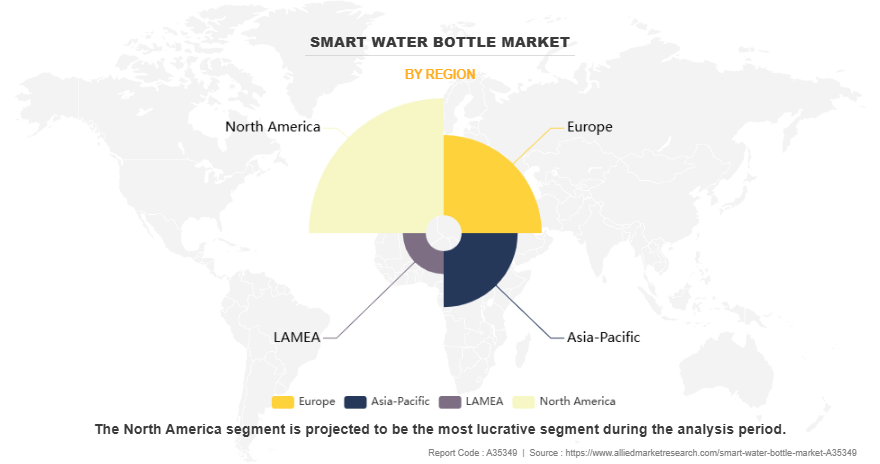
By region, North America is anticipated to dominate the global smart water bottle market with the largest share during the forecast period. An increase in environmental consciousness among consumers has led to a strong preference for sustainable and reusable products such as smart water bottles over single-use plastics. Government regulations have also played a major role; for instance, in September 2023, Massachusetts became the first state to ban the purchase of single-use plastic bottles by state agencies. Outdoor recreational activities, including hiking, camping, and sports, have further fueled demand for smart water bottles, as these bottles help track water intake and maintain beverage temperature in varying weather conditions.
In addition, the work culture in North America, with long commutes and office routines, has also contributed to the popularity of smart water bottles for daily hydration, driving market growth in the region. Moreover, established brands such as HidrateSmart LLC, Bellabeat Inc., and WaterH have played a key role in market expansion by offering high-quality, stylish, and functional designs. Strong marketing strategies and retail presence of smart water bottle brands continue to influence consumer preferences, which has thus made smart water bottles an essential product in the North America market.
Competition Analysis
The key players operating in the global smart water bottle industry include Aquame, Aquaminder Tech Pvt Ltd, Botell Trading Pty Ltd., Ecomo Inc., EQUA d.o.o., Hamilton Housewares Pvt. Ltd., HidrateSmart LLC, Re-Company SA, WaterH, and Zhe Jiang Haers Vacuum Containers Co., Ltd. Several well-known and upcoming brands are vying for market dominance in the expanding market in the region. Smaller, niche firms are more well-known for catering to consumer demands and preferences in the global market. Large conglomerates, however, control most of the market and often buy innovative start-ups to broaden their product lines.
Key Benefits For Stakeholders
- This report provides a quantitative analysis of the market segments, current trends, estimations, and dynamics of the smart water bottle market analysis from 2023 to 2035 to identify the prevailing smart water bottle market opportunities.
- The market research is offered along with information related to key drivers, restraints, and opportunities.
- Porter's five forces analysis highlights the potency of buyers and suppliers to enable stakeholders make profit-oriented business decisions and strengthen their supplier-buyer network.
- In-depth analysis of the smart water bottle market segmentation assists to determine the prevailing market opportunities.
- Major countries in each region are mapped according to their revenue contribution to the global market.
- Market player positioning facilitates benchmarking and provides a clear understanding of the present position of the market players.
- The report includes the analysis of the regional as well as global smart water bottle market trends, key players, market segments, application areas, and market growth strategies.
Smart Water Bottle Market Report Highlights
| Aspects | Details |
| Market Size By 2035 | USD 896.6 million |
| Growth Rate | CAGR of 11.2% |
| Forecast period | 2023 - 2035 |
| Report Pages | 458 |
| By Technology |
|
| By Material |
|
| By Price Range |
|
| By Distribution Channel |
|
| By Region |
|
| Key Market Players | HidrateSmart LLC, Hamilton Housewares Pvt. Ltd., Botell Trading Pty Ltd., Ecomo Inc., WaterH, Re-Company SA, Aquaminder Tech Pvt. Ltd., Aquame, Zhe Jiang Haers Vacuum Containers Co., Ltd., EQUA d.o.o. |
Analyst Review
A smart water bottle is a high-tech hydration container that tracks water intake and reminds users to drink regularly. Sensors, Bluetooth connectivity, and LED lights or alarms provide hydration reminders. Many models sync with mobile apps to set personalized hydration goals. Manufacturers use stainless steel, BPA-free plastic, or glass, often adding insulation for temperature control. The production process involves molding or shaping materials, integrating electronic components, and sealing the bottle to prevent leaks. Athletes, office workers, and health-conscious individuals use smart water bottles to monitor hydration and maintain daily water consumption more efficiently.
The smart water bottle market is divided into technology, material, price range, distribution channel, and region. Based in technology, the market is segmented into hydration tracking sensors, temperature control UV-C sterilization, Bluetooth/Wi-Fi connectivity. Based on material, the market is categorized into stainless steel, plastic, and others. Based on price range, the market is bifurcated into economy, and premium. Based on distribution channel, the market is classified into supermarkets-hypermarkets, departmental stores, online sales channel, and others. By region, the market is analyzed across North America (U.S., Canada, and Mexico), Europe (Germany, UK, France, Italy, Spain, and rest of Europe), Asia-Pacific (China, Japan, India, South Korea, Australia, Singapore, and rest of Asia Pacific), and LAMEA (Brazil, Argentina, South Africa, Saudi Arabia, UAE, and rest of LAMEA).
The global smart water bottle market is analyzed based on its prospect and future growth rate. The report highlights numerous factors that influence the growth of the global smart water bottle market. These factors include market forecast, drivers, restraints, opportunities, and the role of different key players operating in the market. The report emphasizes the current market trends and future growth opportunities of various forms of global smart water bottle in commercial business applications.
The key players profiled in the global smart water bottle market report include Aquame, Aquaminder Tech Pvt Ltd, Botell Trading Pty Ltd., Ecomo Inc., EQUA d.o.o., Hamilton Housewares Pvt. Ltd., HidrateSmart LLC, Re-Company SA, WaterH, and Zhe Jiang Haers Vacuum Containers Co., Ltd.
The global smart water bottle market was valued at $256.9 million in 2023.
Integration with health apps, AI-driven hydration tracking, self-cleaning technology, sustainability, and personalized hydration insights are the upcoming trends of Smart Water Bottle Market in the globe.
Hydration tracking sensors segment is the leading application of Smart Water Bottle Market.
Region-wise, North America is anticipated to dominate the market with the largest share during the global smart water bottle market forecast period.
The key players operating in the global smart water bottle industry include Aquame, Aquaminder Tech Pvt Ltd, Botell Trading Pty Ltd., Ecomo Inc., EQUA d.o.o., Hamilton Housewares Pvt. Ltd., HidrateSmart LLC, Re-Company SA, WaterH, and Zhe Jiang Haers Vacuum Containers Co., Ltd.
Loading Table Of Content...
Loading Research Methodology...
